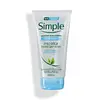Garden of Eden Gentle Milk Cleanser Versus Simple Skincare Water Boost Micellar Cleansing Facial Gel Wash
What's inside
What's inside
 Key Ingredients
Key Ingredients

No key ingredients
 Benefits
Benefits

 Concerns
Concerns

 Ingredients Side-by-side
Ingredients Side-by-side

Water
Skin ConditioningPropylene Glycol
HumectantLauroyl/Myristoyl Methyl Glucamide
EmollientCetearyl Alcohol
EmollientGlyceryl Stearate Se
EmulsifyingEthylhexyl Palmitate
EmollientOctyldodecanol
EmollientCeteareth-25
CleansingPalmitic Acid
EmollientStearic Acid
CleansingGlycerin
HumectantAloe Barbadensis Leaf Extract
EmollientMaltodextrin
AbsorbentParfum
MaskingAllantoin
Skin ConditioningXanthan Gum
EmulsifyingLactic Acid
BufferingMethylchloroisothiazolinone
PreservativeMethylisothiazolinone
PreservativeWater, Propylene Glycol, Lauroyl/Myristoyl Methyl Glucamide, Cetearyl Alcohol, Glyceryl Stearate Se, Ethylhexyl Palmitate, Octyldodecanol, Ceteareth-25, Palmitic Acid, Stearic Acid, Glycerin, Aloe Barbadensis Leaf Extract, Maltodextrin, Parfum, Allantoin, Xanthan Gum, Lactic Acid, Methylchloroisothiazolinone, Methylisothiazolinone
Water
Skin ConditioningCocamidopropyl Betaine
CleansingPropylene Glycol
HumectantHydroxypropyl Methylcellulose
Emulsion StabilisingSodium Chloride
MaskingPanthenol
Skin ConditioningCitric Acid
BufferingDisodium EDTA
Glycerin
HumectantHydroxypropyl Cyclodextrin
MaskingIodopropynyl Butylcarbamate
PreservativePantolactone
HumectantPhenoxyethanol
PreservativePotassium Chloride
Saccharide Isomerate
HumectantSodium Citrate
BufferingSodium Hydroxide
BufferingTocopheryl Acetate
AntioxidantWater, Cocamidopropyl Betaine, Propylene Glycol, Hydroxypropyl Methylcellulose, Sodium Chloride, Panthenol, Citric Acid, Disodium EDTA, Glycerin, Hydroxypropyl Cyclodextrin, Iodopropynyl Butylcarbamate, Pantolactone, Phenoxyethanol, Potassium Chloride, Saccharide Isomerate, Sodium Citrate, Sodium Hydroxide, Tocopheryl Acetate
 Reviews
Reviews

Ingredients Explained
These ingredients are found in both products.
Ingredients higher up in an ingredient list are typically present in a larger amount.
Glycerin is already naturally found in your skin. It helps moisturize and protect your skin.
A study from 2016 found glycerin to be more effective as a humectant than AHAs and hyaluronic acid.
As a humectant, it helps the skin stay hydrated by pulling moisture to your skin. The low molecular weight of glycerin allows it to pull moisture into the deeper layers of your skin.
Hydrated skin improves your skin barrier; Your skin barrier helps protect against irritants and bacteria.
Glycerin has also been found to have antimicrobial and antiviral properties. Due to these properties, glycerin is often used in wound and burn treatments.
In cosmetics, glycerin is usually derived from plants such as soybean or palm. However, it can also be sourced from animals, such as tallow or animal fat.
This ingredient is organic, colorless, odorless, and non-toxic.
Glycerin is the name for this ingredient in American English. British English uses Glycerol/Glycerine.
Learn more about GlycerinPropylene Glycol is an odorless, colorless liquid. As a humectant, it helps skin retain moisture. It also aids in delivering active ingredients.
Another role of this ingredient is preventing a product from melting or freezing. Propylene glycol also adds antimicrobrial properties to a product, elongating product lifespan.
This ingredient is considered an organic alcohol and commonly added into both cosmetics and foods.
Those with sensitive skin or conditions may develop a rash when using this ingredient.
Learn more about Propylene GlycolWater. It's the most common cosmetic ingredient of all. You'll usually see it at the top of ingredient lists, meaning that it makes up the largest part of the product.
So why is it so popular? Water most often acts as a solvent - this means that it helps dissolve other ingredients into the formulation.
You'll also recognize water as that liquid we all need to stay alive. If you see this, drink a glass of water. Stay hydrated!
Learn more about Water